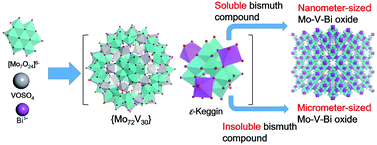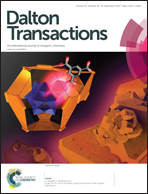Investigation of the formation process of zeolite-like 3D frameworks constructed with ε-Keggin-type polyoxovanadomolybdates with binding bismuth ions and preparation of a nano-crystal†
Abstract
Reaction conditions for the synthesis of an ε-Keggin-type polyoxometalate-based 3D framework, (NH4)2.8H0.9[ε-VMo9.4V2.6O40Bi2]·7.2H2O (denoted as Mo–V–Bi oxide), are studied. It is found that the reaction time, temperature, pH of the solution, and starting compounds affect the production of Mo–V–Bi oxide. The crystal size of Mo–V–Bi oxide is controllable by changing bismuth compounds. Nanometer-sized Mo–V–Bi oxide is produced using a water-soluble bismuth compound, Bi(NO3)3·5H2O, whereas micrometer to submicrometer-sized Mo–V–Bi oxide is produced using Bi(OH)3, which is less soluble in water. The particle size of the material affects the properties of the material, such as surface area and catalysis. The investigation of the formation process of the material is carried out with Raman spectroscopy, which indicates that mixing (NH4)6Mo7O24·4H2O, VOSO4·5H2O, and bismuth ions in water produces the ε-Keggin polyoxovanadomolybdate together with a ball-shaped polyoxovanadomolybdate, [Mo72V30O282(H2O)56(SO4)12]36− (denoted as {Mo72V30}). By heating the reaction mixture, the ε-Keggin polyoxovanadomolybdate assembles with bismuth ions to form Mo–V–Bi oxide, whereas {Mo72V30} assembles with other vanadium and molybdenum ions to form orthorhombic Mo–V oxide.


 Please wait while we load your content...
Please wait while we load your content...